-
20 个实例玩转 Java 8 Stream
20 个实例玩转 Java 8 Stream
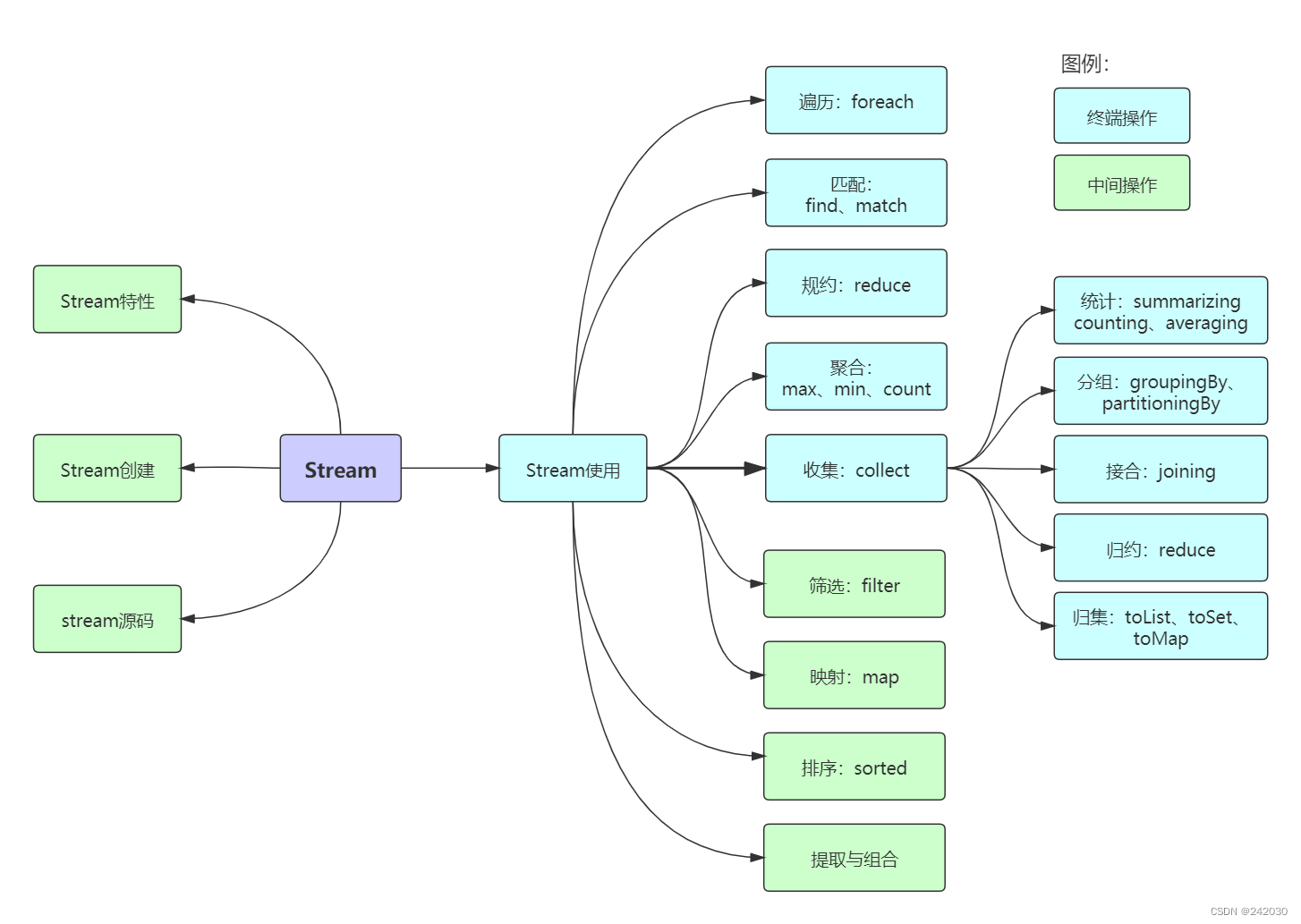
1、Stream概述
Java 8 是一个非常成功的版本,这个版本新增的 Stream,配合同版本出现的 Lambda,给我们操作集合
Collection 提供了极大的便利。
那么什么是 Stream?
Stream 将要处理的元素集合看作一种流,在流的过程中,借助 Stream API 对流中的元素进行操作,比如:
筛选、排序、聚合等。
Stream 可以由数组或集合创建,对流的操作分为两种:
1、中间操作,每次返回一个新的流,可以有多个。
2、终端操作,每个流只能进行一次终端操作,终端操作结束后流无法再次使用。终端操作会产生一个新的集合或
值。
另外,Stream 有几个特性:
1、stream不存储数据,而是按照特定的规则对数据进行计算,一般会输出结果。
2、stream不会改变数据源,通常情况下会产生一个新的集合或一个值。
3、stream具有延迟执行特性,只有调用终端操作时,中间操作才会执行。
2、Stream的创建
Stream 可以通过集合数组创建。
package com.stream.test1; import java.util.Arrays; import java.util.List; import java.util.stream.IntStream; import java.util.stream.Stream; public class Test1 { public static void main(String[] args) { a1(); a2(); a3(); } /** * 1.通过 `java.util.Collection.stream()` 方法用集合创建流 */ public static void a1() { // 通过 `java.util.Collection.stream()` 方法用集合创建流 List<String> list = Arrays.asList("a", "b", "c"); // 创建一个顺序流 Stream<String> stream = list.stream(); // 创建一个并行流 Stream<String> parallelStream = list.parallelStream(); stream.forEach(System.out::println); parallelStream.forEach(System.out::println); } /** * 2.使用`java.util.Arrays.stream(T[] array)`方法用数组创建流 */ public static void a2() { // 使用`java.util.Arrays.stream(T[] array)`方法用数组创建流 int[] array = {1, 3, 5, 6, 8}; IntStream intStream = Arrays.stream(array); intStream.forEach(System.out::println); } /** * 3.使用`Stream`的静态方法:`of()、iterate()、generate()` */ public static void a3() { // 使用`Stream`的静态方法:`of()、iterate()、generate()` Stream<Integer> stream1 = Stream.of(1, 2, 3, 4, 5, 6); stream1.forEach(System.out::println); Stream<Integer> stream2 = Stream.iterate(0, (x) -> x + 3).limit(4); stream2.forEach(System.out::println); Stream<Double> stream3 = Stream.generate(Math::random).limit(3); stream3.forEach(System.out::println); } }- 1
- 2
- 3
- 4
- 5
- 6
- 7
- 8
- 9
- 10
- 11
- 12
- 13
- 14
- 15
- 16
- 17
- 18
- 19
- 20
- 21
- 22
- 23
- 24
- 25
- 26
- 27
- 28
- 29
- 30
- 31
- 32
- 33
- 34
- 35
- 36
- 37
- 38
- 39
- 40
- 41
- 42
- 43
- 44
- 45
- 46
- 47
- 48
- 49
- 50
- 51
- 52
- 53
# 程序输出 a b c b c a ---------- 1 3 5 6 8 ---------- 1 2 3 4 5 6 0 3 6 9 0.7408527501587401 0.5636765964381898 0.36334100319238094- 1
- 2
- 3
- 4
- 5
- 6
- 7
- 8
- 9
- 10
- 11
- 12
- 13
- 14
- 15
- 16
- 17
- 18
- 19
- 20
- 21
- 22
- 23
- 24
- 25
- 26
- 27
stream 和 parallelStream 的简单区分:stream 是顺序流,由主线程按顺序对流执行操作,而 parallelStream 是
并行流,内部以多线程并行执行的方式对流进行操作,但前提是流中的数据处理没有顺序要求。例如筛选集合中的
奇数,两者的处理不同之处:
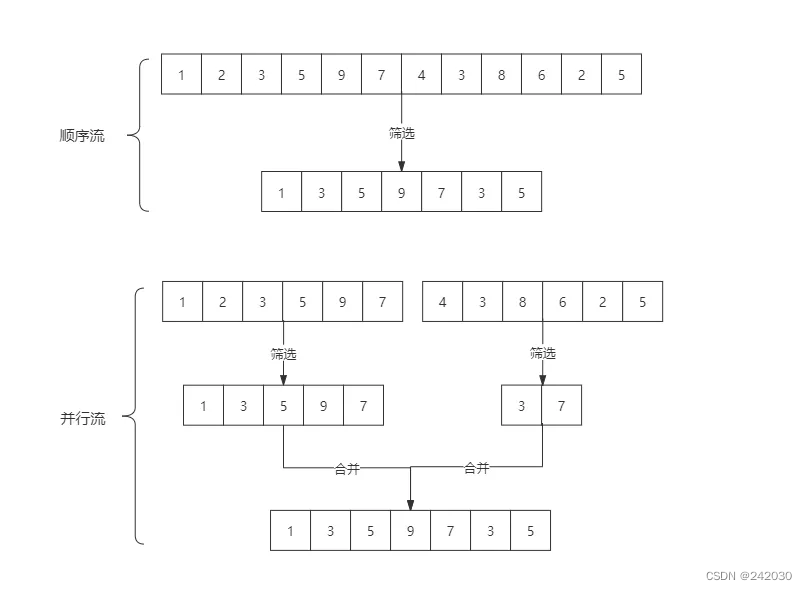
如果流中的数据量足够大,并行流可以加快处速度。
Java 8 创建 Stream 的 10 种方式:
(1)、Stream.of 可变参数
Stream<String> stream1 = Stream.of("A", "B", "C"); System.out.println("stream1:" + stream1.collect(joining()));- 1
- 2
程序输出:stream1: ABC
(2)、Stream.of 数组
String[] values = new String[]{"A", "B", "C"}; Stream<String> stream2 = Stream.of(values); System.out.println("stream2:" + stream2.collect(joining()));- 1
- 2
- 3
程序输出:stream2: ABC
看 Stream.of 源码,上面这两种方式其实就是第三种方式的包装版。
public static<T> Stream<T> of(T... values) { return Arrays.stream(values); }- 1
- 2
- 3
我们直接使用源码中的方式也是一样的。
(3)、Arrays.stream
String[] values = new String[]{"A", "B", "C"}; Stream<String> stream3 = Arrays.stream(values); System.out.println("stream3:" + stream3.collect(joining()));- 1
- 2
- 3
程序输出:stream3: ABC
(4)、List
List<String> list = Arrays.asList("A", "B", "C"); Stream<String> stream4 = list.stream(); System.out.println("stream4:" + stream4.collect(joining()));- 1
- 2
- 3
程序输出:stream4: ABC
(5)、Set
Set<String> set = new HashSet<>(Arrays.asList("A", "B", "C")); Stream<String> stream5 = set.stream(); System.out.println("stream5:" + stream5.collect(joining()));- 1
- 2
- 3
程序输出:stream5: ABC
(6)、Map
Map<String, String> map = new HashMap<>(); map.put("1", "A"); map.put("2", "B"); map.put("3", "C"); Stream<String> stream6 = map.values().stream(); System.out.println("stream6:" + stream6.collect(joining()));- 1
- 2
- 3
- 4
- 5
- 6
程序输出:stream6: ABC
(7)、Stream.iterate
Stream<String> stream7 = Stream.iterate("A", e -> String.valueOf((char) (e.charAt(0) + 1))).limit(3); System.out.println("stream7:" + stream7.collect(joining()));- 1
- 2
程序输出:stream7: ABC
(8)、Pattern
String value = "A B C"; Stream<String> stream8 = Pattern.compile("\\W").splitAsStream(value); System.out.println("stream8:" + stream8.collect(joining()));- 1
- 2
- 3
程序输出:stream8: ABC
(9)、Files.lines
try { Stream<String> stream9 = Files.lines(Paths.get("d:/data.txt")); System.out.println("stream9:" + stream9.collect(joining())); } catch (IOException e) { e.printStackTrace(); }- 1
- 2
- 3
- 4
- 5
- 6
data.txt文件内容如下:
A B C- 1
- 2
- 3
程序输出:stream9: ABC
(10)、Stream.generate
Stream<String> stream10 = Stream.generate(() -> "A").limit(3); System.out.println("stream10:" + stream10.collect(joining()));- 1
- 2
程序输出:stream10: AAA
(11)、顺序流转换为并行流
除了直接创建并行流,还可以通过 parallel() 把顺序流转换成并行流:
Optional<Integer> findFirst = list.stream().parallel().filter(x->x>6).findFirst();- 1
完整代码:
package com.stream.test2; import java.io.IOException; import java.nio.file.Files; import java.nio.file.Paths; import java.util.*; import java.util.regex.Pattern; import java.util.stream.Stream; public class Test2 { public static void main(String[] args) { a1(); System.out.println("----------"); a2(); System.out.println("----------"); a3(); System.out.println("----------"); a4(); System.out.println("----------"); a5(); System.out.println("----------"); a6(); System.out.println("----------"); a7(); System.out.println("----------"); a8(); System.out.println("----------"); a9(); System.out.println("----------"); a10(); System.out.println("----------"); a11(); } /** * 1.Stream.of 可变参数 */ public static void a1() { Stream<String> stream1 = Stream.of("A", "B", "C"); stream1.forEach(System.out::println); } /** * 2.Stream.of 数组 */ public static void a2() { String[] values = new String[]{"A", "B", "C"}; Stream<String> stream2 = Stream.of(values); stream2.forEach(System.out::println); } /** * 3.Arrays.stream */ public static void a3() { String[] values = new String[]{"A", "B", "C"}; Stream<String> stream3 = Arrays.stream(values); stream3.forEach(System.out::println); } /** * 4.List */ public static void a4() { List<String> list = Arrays.asList("A", "B", "C"); Stream<String> stream4 = list.stream(); stream4.forEach(System.out::println); } /** * 5.Set */ public static void a5() { Set<String> set = new HashSet<>(Arrays.asList("A", "B", "C")); Stream<String> stream5 = set.stream(); stream5.forEach(System.out::println); } /** * 6.Map */ public static void a6() { Map<String, String> map = new HashMap<>(); map.put("1", "A"); map.put("2", "B"); map.put("3", "C"); Stream<String> stream6 = map.values().stream(); stream6.forEach(System.out::println); } /** * 7.Stream.iterate */ public static void a7() { Stream<String> stream7 = Stream.iterate("A", e -> String.valueOf((char) (e.charAt(0) + 1))).limit(3); stream7.forEach(System.out::println); } /** * 8.Pattern */ public static void a8() { String value = "A B C"; Stream<String> stream8 = Pattern.compile("\\W").splitAsStream(value); stream8.forEach(System.out::println); } /** * 9.Files.lines */ public static void a9() { try { Stream<String> stream9 = Files.lines(Paths.get("D:\\data.txt")); stream9.forEach(System.out::println); } catch (IOException e) { e.printStackTrace(); } } /** * 10.Stream.generate */ public static void a10() { Stream<String> stream10 = Stream.generate(() -> "A").limit(3); stream10.forEach(System.out::println); } /** * 11.通过`parallel()`把顺序流转换成并行流 */ public static void a11() { List<Integer> list = Arrays.asList(1, 7, 14); Optional<Integer> findFirst = list.stream().parallel().filter(x -> (x > 6)).findFirst(); System.out.println(findFirst.get()); } }- 1
- 2
- 3
- 4
- 5
- 6
- 7
- 8
- 9
- 10
- 11
- 12
- 13
- 14
- 15
- 16
- 17
- 18
- 19
- 20
- 21
- 22
- 23
- 24
- 25
- 26
- 27
- 28
- 29
- 30
- 31
- 32
- 33
- 34
- 35
- 36
- 37
- 38
- 39
- 40
- 41
- 42
- 43
- 44
- 45
- 46
- 47
- 48
- 49
- 50
- 51
- 52
- 53
- 54
- 55
- 56
- 57
- 58
- 59
- 60
- 61
- 62
- 63
- 64
- 65
- 66
- 67
- 68
- 69
- 70
- 71
- 72
- 73
- 74
- 75
- 76
- 77
- 78
- 79
- 80
- 81
- 82
- 83
- 84
- 85
- 86
- 87
- 88
- 89
- 90
- 91
- 92
- 93
- 94
- 95
- 96
- 97
- 98
- 99
- 100
- 101
- 102
- 103
- 104
- 105
- 106
- 107
- 108
- 109
- 110
- 111
- 112
- 113
- 114
- 115
- 116
- 117
- 118
- 119
- 120
- 121
- 122
- 123
- 124
- 125
- 126
- 127
- 128
- 129
- 130
- 131
- 132
- 133
- 134
- 135
- 136
- 137
- 138
- 139
- 140
# 程序输出 A B C ---------- A B C ---------- A B C ---------- A B C ---------- A B C ---------- A B C ---------- A B C ---------- A B C ---------- 11 22 ---------- A A A ---------- 7- 1
- 2
- 3
- 4
- 5
- 6
- 7
- 8
- 9
- 10
- 11
- 12
- 13
- 14
- 15
- 16
- 17
- 18
- 19
- 20
- 21
- 22
- 23
- 24
- 25
- 26
- 27
- 28
- 29
- 30
- 31
- 32
- 33
- 34
- 35
- 36
- 37
- 38
- 39
- 40
- 41
3、Stream的使用
在使用 stream 之前,先理解一个概念:Optional。
Optional 类是一个可以为 null 的容器对象。如果值存在则 isPresent() 方法会返回 true,调用 get() 方法会返
回该对象。
3.1 员工类
package com.stream.common; public class Person { /** * 姓名 */ private String name; /** * 薪资 */ private int salary; /** * 年龄 */ private int age; /** * 性别 */ private String sex; /** * 地区 */ private String area; /** * 构造方法 * * @param name * @param salary * @param age * @param sex * @param area */ public Person(String name, int salary, int age, String sex, String area) { this.name = name; this.salary = salary; this.age = age; this.sex = sex; this.area = area; } public String getName() { return name; } public void setName(String name) { this.name = name; } public int getSalary() { return salary; } public void setSalary(int salary) { this.salary = salary; } public int getAge() { return age; } public void setAge(int age) { this.age = age; } public String getSex() { return sex; } public void setSex(String sex) { this.sex = sex; } public String getArea() { return area; } public void setArea(String area) { this.area = area; } }- 1
- 2
- 3
- 4
- 5
- 6
- 7
- 8
- 9
- 10
- 11
- 12
- 13
- 14
- 15
- 16
- 17
- 18
- 19
- 20
- 21
- 22
- 23
- 24
- 25
- 26
- 27
- 28
- 29
- 30
- 31
- 32
- 33
- 34
- 35
- 36
- 37
- 38
- 39
- 40
- 41
- 42
- 43
- 44
- 45
- 46
- 47
- 48
- 49
- 50
- 51
- 52
- 53
- 54
- 55
- 56
- 57
- 58
- 59
- 60
- 61
- 62
- 63
- 64
- 65
- 66
- 67
- 68
- 69
- 70
- 71
- 72
- 73
- 74
- 75
- 76
- 77
- 78
- 79
- 80
- 81
- 82
- 83
- 84
- 85
- 86
- 87
3.2 遍历/匹配(foreach/find/match)
Stream 也是支持类似集合的遍历和匹配元素的,只是 Stream 中的元素是以 Optional 类型存在的。Stream 的遍
历、匹配非常简单。
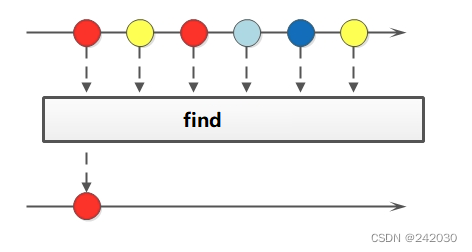
package com.stream.test3; import java.util.Arrays; import java.util.List; import java.util.Optional; public class Test3 { /** * 遍历/匹配(foreach/find/match) * * @param args */ public static void main(String[] args) { List<Integer> list = Arrays.asList(7, 6, 9, 3, 8, 2, 1); // 遍历输出符合条件的元素 list.stream().filter(x -> x > 6).forEach(System.out::println); // 匹配第一个 Optional<Integer> findFirst = list.stream().filter(x -> x > 6).findFirst(); // 匹配任意(适用于并行流) Optional<Integer> findAny = list.parallelStream().filter(x -> x > 6).findAny(); // 是否包含符合特定条件的元素 boolean anyMatch = list.stream().anyMatch(x -> x < 6); System.out.println("匹配第一个值:" + findFirst.get()); System.out.println("匹配任意一个值:" + findAny.get()); System.out.println("是否存在大于6的值:" + anyMatch); } }- 1
- 2
- 3
- 4
- 5
- 6
- 7
- 8
- 9
- 10
- 11
- 12
- 13
- 14
- 15
- 16
- 17
- 18
- 19
- 20
- 21
- 22
- 23
- 24
- 25
- 26
- 27
- 28
- 29
# 程序输出 7 9 8 匹配第一个值:7 匹配任意一个值:8 是否存在大于6的值:true- 1
- 2
- 3
- 4
- 5
- 6
- 7
3.3 筛选(filter)
筛选,是按照一定的规则校验流中的元素,将符合条件的元素提取到新的流中的操作。
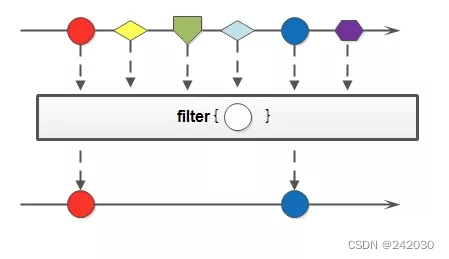
package com.stream.test4; import com.stream.common.Person; import java.util.ArrayList; import java.util.Arrays; import java.util.List; import java.util.stream.Collectors; import java.util.stream.Stream; public class Test4 { /** * 筛选(filter) * * @param args */ public static void main(String[] args) { a1(); System.out.println("----------"); a2(); } /** * 案例一:筛选出`Integer`集合中大于7的元素,并打印出来 */ public static void a1() { List<Integer> list = Arrays.asList(6, 7, 3, 8, 1, 2, 9); Stream<Integer> stream = list.stream(); stream.filter(x -> x > 7).forEach(System.out::println); } /** * 案例二:筛选员工中工资高于8000的人,并形成新的集合。 */ public static void a2() { List<Person> personList = new ArrayList<Person>(); personList.add(new Person("Tom", 8900, 23, "male", "New York")); personList.add(new Person("Jack", 7000, 25, "male", "Washington")); personList.add(new Person("Lily", 7800, 21, "female", "Washington")); personList.add(new Person("Anni", 8200, 24, "female", "New York")); personList.add(new Person("Owen", 9500, 25, "male", "New York")); personList.add(new Person("Alisa", 7900, 26, "female", "New York")); List<String> filterList = personList.stream().filter(x -> x.getSalary() > 8000).map(Person::getName).collect(Collectors.toList()); System.out.print("高于8000的员工姓名:" + filterList); } }- 1
- 2
- 3
- 4
- 5
- 6
- 7
- 8
- 9
- 10
- 11
- 12
- 13
- 14
- 15
- 16
- 17
- 18
- 19
- 20
- 21
- 22
- 23
- 24
- 25
- 26
- 27
- 28
- 29
- 30
- 31
- 32
- 33
- 34
- 35
- 36
- 37
- 38
- 39
- 40
- 41
- 42
- 43
- 44
- 45
- 46
- 47
# 程序输出 8 9 ---------- 高于8000的员工姓名:[Tom, Anni, Owen]- 1
- 2
- 3
- 4
- 5
3.4 聚合(max/min/count)
max、min、count 这些字眼你一定不陌生,没错,在mysql中我们常用它们进行数据统计。Java stream中也引
入了这些概念和用法,极大地方便了我们对集合、数组的数据统计工作。
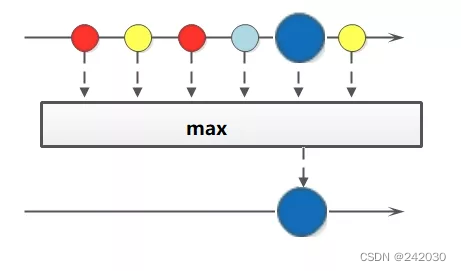
package com.stream.test5; import com.stream.common.Person; import java.util.*; public class Test5 { /** * 聚合(max/min/count) * * @param args */ public static void main(String[] args) { a1(); System.out.println("----------"); a2(); System.out.println("----------"); a3(); System.out.println("----------"); a4(); } /** * 案例一:获取`String`集合中最长的元素。 */ public static void a1() { List<String> list = Arrays.asList("adnm", "admmt", "pot", "xbangd", "weoujgsd"); Optional<String> max = list.stream().max(Comparator.comparing(String::length)); System.out.println("最长的字符串:" + max.get()); } /** * 案例二:获取`Integer`集合中的最大值。 */ public static void a2() { List<Integer> list = Arrays.asList(7, 6, 9, 4, 11, 6); // 自然排序 Optional<Integer> max = list.stream().max(Integer::compareTo); // 自定义排序 Optional<Integer> max2 = list.stream().max(new Comparator<Integer>() { @Override public int compare(Integer o1, Integer o2) { return o1.compareTo(o2); } }); System.out.println("自然排序的最大值:" + max.get()); System.out.println("自定义排序的最大值:" + max2.get()); } /** * 案例三:获取员工工资最高的人。 */ public static void a3() { List<Person> personList = new ArrayList<Person>(); personList.add(new Person("Tom", 8900, 23, "male", "New York")); personList.add(new Person("Jack", 7000, 25, "male", "Washington")); personList.add(new Person("Lily", 7800, 21, "female", "Washington")); personList.add(new Person("Anni", 8200, 24, "female", "New York")); personList.add(new Person("Owen", 9500, 25, "male", "New York")); personList.add(new Person("Alisa", 7900, 26, "female", "New York")); Optional<Person> max = personList.stream().max(Comparator.comparingInt(Person::getSalary)); System.out.println("员工工资最大值:" + max.get().getSalary()); } /** * 案例四:计算`Integer`集合中大于6的元素的个数。 */ public static void a4() { List<Integer> list = Arrays.asList(7, 6, 4, 8, 2, 11, 9); long count = list.stream().filter(x -> x > 6).count(); System.out.println("list中大于6的元素个数:" + count); } }- 1
- 2
- 3
- 4
- 5
- 6
- 7
- 8
- 9
- 10
- 11
- 12
- 13
- 14
- 15
- 16
- 17
- 18
- 19
- 20
- 21
- 22
- 23
- 24
- 25
- 26
- 27
- 28
- 29
- 30
- 31
- 32
- 33
- 34
- 35
- 36
- 37
- 38
- 39
- 40
- 41
- 42
- 43
- 44
- 45
- 46
- 47
- 48
- 49
- 50
- 51
- 52
- 53
- 54
- 55
- 56
- 57
- 58
- 59
- 60
- 61
- 62
- 63
- 64
- 65
- 66
- 67
- 68
- 69
- 70
- 71
- 72
- 73
- 74
- 75
# 程序输出 最长的字符串:weoujgsd ---------- 自然排序的最大值:11 自定义排序的最大值:11 ---------- 员工工资最大值:9500 ---------- list中大于6的元素个数:4- 1
- 2
- 3
- 4
- 5
- 6
- 7
- 8
- 9
3.5 映射(map/flatMap)
映射,可以将一个流的元素按照一定的映射规则映射到另一个流中。分为 map 和 flatMap:
- map:接收一个函数作为参数,该函数会被应用到每个元素上,并将其映射成一个新的元素。
- flatMap:接收一个函数作为参数,将流中的每个值都换成另一个流,然后把所有流连接成一个流。
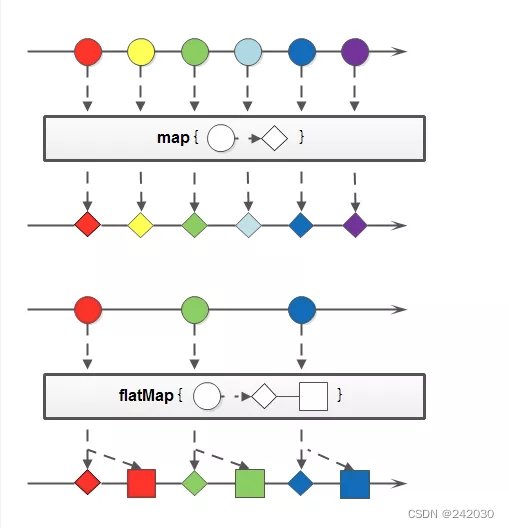
package com.stream.test6; import com.stream.common.Person; import java.util.ArrayList; import java.util.Arrays; import java.util.List; import java.util.stream.Collectors; import java.util.stream.Stream; public class Test6 { /** * 映射(map/flatMap) * * @param args */ public static void main(String[] args) { a1(); System.out.println("----------"); a2(); System.out.println("----------"); a3(); } /** * 案例一:英文字符串数组的元素全部改为大写。整数数组每个元素+3 */ public static void a1() { String[] strArr = {"abcd", "bcdd", "defde", "fTr"}; List<String> strList = Arrays.stream(strArr).map(String::toUpperCase).collect(Collectors.toList()); List<Integer> intList = Arrays.asList(1, 3, 5, 7, 9, 11); List<Integer> intListNew = intList.stream().map(x -> x + 3).collect(Collectors.toList()); System.out.println("每个元素大写:" + strList); System.out.println("每个元素+3:" + intListNew); } /** * 案例二:将员工的薪资全部增加1000 */ public static void a2() { List<Person> personList = new ArrayList<Person>(); personList.add(new Person("Tom", 8900, 23, "male", "New York")); personList.add(new Person("Jack", 7000, 25, "male", "Washington")); personList.add(new Person("Lily", 7800, 21, "female", "Washington")); personList.add(new Person("Anni", 8200, 24, "female", "New York")); personList.add(new Person("Owen", 9500, 25, "male", "New York")); personList.add(new Person("Alisa", 7900, 26, "female", "New York")); // 不改变原来员工集合的方式 List<Person> personListNew = personList.stream().map(person -> { Person personNew = new Person(person.getName(), 0, 0, null, null); personNew.setSalary(person.getSalary() + 10000); return personNew; }).collect(Collectors.toList()); System.out.println("一次改动前:" + personList.get(0).getName() + "-->" + personList.get(0).getSalary()); System.out.println("一次改动后:" + personListNew.get(0).getName() + "-->" + personListNew.get(0).getSalary()); // 改变原来员工集合的方式 List<Person> personListNew2 = personList.stream().map(person -> { person.setSalary(person.getSalary() + 10000); return person; }).collect(Collectors.toList()); System.out.println("二次改动前:" + personList.get(0).getName() + "-->" + personListNew.get(0).getSalary()); System.out.println("二次改动后:" + personListNew2.get(0).getName() + "-->" + personListNew.get(0).getSalary()); } /** * 案例三:将两个字符数组合并成一个新的字符数组 */ public static void a3() { List<String> list = Arrays.asList("m,k,l,a", "1,3,5,7"); List<String> listNew = list.stream().flatMap(s -> { // 将每个元素转换成一个stream String[] split = s.split(","); Stream<String> s2 = Arrays.stream(split); return s2; }).collect(Collectors.toList()); System.out.println("处理前的集合:" + list); System.out.println("处理后的集合:" + listNew); } }- 1
- 2
- 3
- 4
- 5
- 6
- 7
- 8
- 9
- 10
- 11
- 12
- 13
- 14
- 15
- 16
- 17
- 18
- 19
- 20
- 21
- 22
- 23
- 24
- 25
- 26
- 27
- 28
- 29
- 30
- 31
- 32
- 33
- 34
- 35
- 36
- 37
- 38
- 39
- 40
- 41
- 42
- 43
- 44
- 45
- 46
- 47
- 48
- 49
- 50
- 51
- 52
- 53
- 54
- 55
- 56
- 57
- 58
- 59
- 60
- 61
- 62
- 63
- 64
- 65
- 66
- 67
- 68
- 69
- 70
- 71
- 72
- 73
- 74
- 75
- 76
- 77
- 78
- 79
- 80
- 81
# 程序输出 每个元素大写:[ABCD, BCDD, DEFDE, FTR] 每个元素+3:[4, 6, 8, 10, 12, 14] ---------- 一次改动前:Tom-->8900 一次改动后:Tom-->18900 二次改动前:Tom-->18900 二次改动后:Tom-->18900 ---------- 处理前的集合:[m,k,l,a, 1,3,5,7] 处理后的集合:[m, k, l, a, 1, 3, 5, 7]- 1
- 2
- 3
- 4
- 5
- 6
- 7
- 8
- 9
- 10
- 11
3.6 归约(reduce)
归约,也称缩减,顾名思义,是把一个流缩减成一个值,能实现对集合求和、求乘积和求最值操作。

package com.stream.test7; import com.stream.common.Person; import java.util.ArrayList; import java.util.Arrays; import java.util.List; import java.util.Optional; public class Test7 { /** * 归约(reduce) * * @param args */ public static void main(String[] args) { a1(); System.out.println("----------"); a2(); } /** * 案例一:求`Integer`集合的元素之和、乘积和最大值 */ public static void a1() { List<Integer> list = Arrays.asList(1, 3, 2, 8, 11, 4); // 求和方式1 Optional<Integer> sum = list.stream().reduce((x, y) -> x + y); // 求和方式2 Optional<Integer> sum2 = list.stream().reduce(Integer::sum); // 求和方式3 Integer sum3 = list.stream().reduce(0, Integer::sum); // 求乘积 Optional<Integer> product = list.stream().reduce((x, y) -> x * y); // 求最大值方式1 Optional<Integer> max = list.stream().reduce((x, y) -> x > y ? x : y); // 求最大值写法2 Integer max2 = list.stream().reduce(1, Integer::max); System.out.println("list求和:" + sum.get() + "," + sum2.get() + "," + sum3); System.out.println("list求积:" + product.get()); System.out.println("list求和:" + max.get() + "," + max2); } /** * 案例二:求所有员工的工资之和和最高工资 */ public static void a2() { List<Person> personList = new ArrayList<Person>(); personList.add(new Person("Tom", 8900, 23, "male", "New York")); personList.add(new Person("Jack", 7000, 25, "male", "Washington")); personList.add(new Person("Lily", 7800, 21, "female", "Washington")); personList.add(new Person("Anni", 8200, 24, "female", "New York")); personList.add(new Person("Owen", 9500, 25, "male", "New York")); personList.add(new Person("Alisa", 7900, 26, "female", "New York")); // 求工资之和方式1: Optional<Integer> sumSalary = personList.stream().map(Person::getSalary).reduce(Integer::sum); // 求工资之和方式2: Integer sumSalary2 = personList.stream().reduce(0, (sum, p) -> sum += p.getSalary(), (sum1, sum2) -> sum1 + sum2); // 求工资之和方式3: Integer sumSalary3 = personList.stream().reduce(0, (sum, p) -> sum += p.getSalary(), Integer::sum); // 求最高工资方式1: Integer maxSalary = personList.stream().reduce(0, (max, p) -> max > p.getSalary() ? max : p.getSalary(), Integer::max); // 求最高工资方式2: Integer maxSalary2 = personList.stream().reduce(0, (max, p) -> max > p.getSalary() ? max : p.getSalary(), (max1, max2) -> max1 > max2 ? max1 : max2); System.out.println("工资之和:" + sumSalary.get() + "," + sumSalary2 + "," + sumSalary3); System.out.println("最高工资:" + maxSalary + "," + maxSalary2); } }- 1
- 2
- 3
- 4
- 5
- 6
- 7
- 8
- 9
- 10
- 11
- 12
- 13
- 14
- 15
- 16
- 17
- 18
- 19
- 20
- 21
- 22
- 23
- 24
- 25
- 26
- 27
- 28
- 29
- 30
- 31
- 32
- 33
- 34
- 35
- 36
- 37
- 38
- 39
- 40
- 41
- 42
- 43
- 44
- 45
- 46
- 47
- 48
- 49
- 50
- 51
- 52
- 53
- 54
- 55
- 56
- 57
- 58
- 59
- 60
- 61
- 62
- 63
- 64
- 65
- 66
- 67
- 68
- 69
- 70
- 71
# 程序输出 list求和:29,29,29 list求积:2112 list求和:11,11 ---------- 工资之和:49300,49300,49300 最高工资:9500,9500- 1
- 2
- 3
- 4
- 5
- 6
- 7
3.7 收集(collect)
collect,收集,可以说是内容最繁多、功能最丰富的部分了。从字面上去理解,就是把一个流收集起来,最终可以
是收集成一个值也可以收集成一个新的集合。
collect 主要依赖 java.util.stream.Collectors 类内置的静态方法。
3.6.1 归集(toList/toSet/toMap)
因为流不存储数据,那么在流中的数据完成处理后,需要将流中的数据重新归集到新的集合里。
toList、toSet和
toMap比较常用,另外还有toCollection、toConcurrentMap等复杂一些的用法。package com.stream.test8; import com.stream.common.Person; import java.util.*; import java.util.stream.Collectors; public class Test8 { /** * 归集(toList/toSet/toMap) * * @param args */ public static void main(String[] args) { a(); } /** * toList`、`toSet`和`toMap` */ public static void a() { List<Integer> list = Arrays.asList(1, 6, 3, 4, 6, 7, 9, 6, 20); List<Integer> listNew = list.stream().filter(x -> x % 2 == 0).collect(Collectors.toList()); Set<Integer> set = list.stream().filter(x -> x % 2 == 0).collect(Collectors.toSet()); List<Person> personList = new ArrayList<Person>(); personList.add(new Person("Tom", 8900, 23, "male", "New York")); personList.add(new Person("Jack", 7000, 25, "male", "Washington")); personList.add(new Person("Lily", 7800, 21, "female", "Washington")); personList.add(new Person("Anni", 8200, 24, "female", "New York")); Map<?, Person> map = personList.stream().filter(p -> p.getSalary() > 8000) .collect(Collectors.toMap(Person::getName, p -> p)); System.out.println("toList:" + listNew); System.out.println("toSet:" + set); System.out.println("toMap:" + map); } }- 1
- 2
- 3
- 4
- 5
- 6
- 7
- 8
- 9
- 10
- 11
- 12
- 13
- 14
- 15
- 16
- 17
- 18
- 19
- 20
- 21
- 22
- 23
- 24
- 25
- 26
- 27
- 28
- 29
- 30
- 31
- 32
- 33
- 34
- 35
- 36
- 37
- 38
运行结果:
# 程序输出 toList:[6, 4, 6, 6, 20] toSet:[4, 20, 6] toMap:{Tom=com.stream.common.Person@2dda6444, Anni=com.stream.common.Person@5e9f23b4}- 1
- 2
- 3
- 4
3.6.2 统计(count/averaging)
Collectors 提供了一系列用于数据统计的静态方法:
- 计数:
count - 平均值:
averagingInt、averagingLong、averagingDouble - 最值:
maxBy、minBy - 求和:
summingInt、summingLong、summingDouble - 统计以上所有:
summarizingInt、summarizingLong、summarizingDouble
package com.stream.test9; import com.stream.common.Person; import java.util.ArrayList; import java.util.DoubleSummaryStatistics; import java.util.List; import java.util.Optional; import java.util.stream.Collectors; public class Test9 { /** * 统计(count/averaging) * * @param args */ public static void main(String[] args) { a(); } /** * 案例:统计员工人数、平均工资、工资总额、最高工资 */ public static void a() { List<Person> personList = new ArrayList<Person>(); personList.add(new Person("Tom", 8900, 23, "male", "New York")); personList.add(new Person("Jack", 7000, 25, "male", "Washington")); personList.add(new Person("Lily", 7800, 21, "female", "Washington")); // 求总数 Long count = personList.stream().collect(Collectors.counting()); // 求平均工资 Double average = personList.stream().collect(Collectors.averagingDouble(Person::getSalary)); // 求最高工资 Optional<Integer> max = personList.stream().map(Person::getSalary).collect(Collectors.maxBy(Integer::compare)); // 求工资之和 Integer sum = personList.stream().collect(Collectors.summingInt(Person::getSalary)); // 一次性统计所有信息 DoubleSummaryStatistics collect = personList.stream().collect(Collectors.summarizingDouble(Person::getSalary)); System.out.println("员工总数:" + count); System.out.println("员工平均工资:" + average); System.out.println("员工工资总和:" + sum); System.out.println("员工工资所有统计:" + collect); } }- 1
- 2
- 3
- 4
- 5
- 6
- 7
- 8
- 9
- 10
- 11
- 12
- 13
- 14
- 15
- 16
- 17
- 18
- 19
- 20
- 21
- 22
- 23
- 24
- 25
- 26
- 27
- 28
- 29
- 30
- 31
- 32
- 33
- 34
- 35
- 36
- 37
- 38
- 39
- 40
- 41
- 42
- 43
- 44
- 45
# 程序输出 员工总数:3 员工平均工资:7900.0 员工工资总和:23700 员工工资所有统计:DoubleSummaryStatistics{count=3, sum=23700.000000, min=7000.000000, average=7900.000000, max=8900.000000}- 1
- 2
- 3
- 4
- 5
3.6.3 分组(partitioningBy/groupingBy)
- 分区:将 stream 按条件分为两个 Map,比如员工按薪资是否高于8000分为两部分。
- 分组:将集合分为多个Map,比如员工按性别分组。有单级分组和多级分组。

package com.stream.test10; import com.stream.common.Person; import java.util.ArrayList; import java.util.List; import java.util.Map; import java.util.stream.Collectors; public class Test10 { /** * 分组(partitioningBy/groupingBy) * * @param args */ public static void main(String[] args) { a(); } /** * 案例:将员工按薪资是否高于8000分为两部分;将员工按性别和地区分组 */ public static void a() { List<Person> personList = new ArrayList<Person>(); personList.add(new Person("Tom", 8900, 23, "male", "New York")); personList.add(new Person("Jack", 7000, 25, "male", "Washington")); personList.add(new Person("Lily", 7800, 21, "female", "Washington")); personList.add(new Person("Anni", 8200, 27, "female", "New York")); personList.add(new Person("Owen", 9500, 22, "male", "New York")); personList.add(new Person("Alisa", 7900, 20, "female", "New York")); // 将员工按薪资是否高于8000分组 Map<Boolean, List<Person>> part = personList.stream().collect(Collectors.partitioningBy(x -> x.getSalary() > 8000)); // 将员工按性别分组 Map<String, List<Person>> group = personList.stream().collect(Collectors.groupingBy(Person::getSex)); // 将员工先按性别分组,再按地区分组 Map<String, Map<String, List<Person>>> group2 = personList.stream().collect(Collectors.groupingBy(Person::getSex, Collectors.groupingBy(Person::getArea))); System.out.println("员工按薪资是否大于8000分组情况:" + part); System.out.println("员工按性别分组情况:" + group); System.out.println("员工按性别、地区:" + group2); } }- 1
- 2
- 3
- 4
- 5
- 6
- 7
- 8
- 9
- 10
- 11
- 12
- 13
- 14
- 15
- 16
- 17
- 18
- 19
- 20
- 21
- 22
- 23
- 24
- 25
- 26
- 27
- 28
- 29
- 30
- 31
- 32
- 33
- 34
- 35
- 36
- 37
- 38
- 39
- 40
- 41
- 42
# 程序输出 员工按薪资是否大于8000分组情况:{false=[com.stream.common.Person@5e9f23b4, com.stream.common.Person@4783da3f, com.stream.common.Person@378fd1ac], true=[com.stream.common.Person@49097b5d, com.stream.common.Person@6e2c634b, com.stream.common.Person@37a71e93]} 员工按性别分组情况:{female=[com.stream.common.Person@4783da3f, com.stream.common.Person@6e2c634b, com.stream.common.Person@378fd1ac], male=[com.stream.common.Person@49097b5d, com.stream.common.Person@5e9f23b4, com.stream.common.Person@37a71e93]} 员工按性别、地区:{female={New York=[com.stream.common.Person@6e2c634b, com.stream.common.Person@378fd1ac], Washington=[com.stream.common.Person@4783da3f]}, male={New York=[com.stream.common.Person@49097b5d, com.stream.common.Person@37a71e93], Washington=[com.stream.common.Person@5e9f23b4]}}- 1
- 2
- 3
- 4
3.6.4 接合(joining)
joining 可以将stream中的元素用特定的连接符(没有的话,则直接连接)连接成一个字符串。
package com.stream.test11; import com.stream.common.Person; import java.util.ArrayList; import java.util.Arrays; import java.util.List; import java.util.stream.Collectors; public class Test11 { /** * 接合(joining) * * @param args */ public static void main(String[] args) { List<Person> personList = new ArrayList<Person>(); personList.add(new Person("Tom", 8900, 23, "male", "New York")); personList.add(new Person("Jack", 7000, 25, "male", "Washington")); personList.add(new Person("Lily", 7800, 21, "female", "Washington")); String names = personList.stream().map(p -> p.getName()).collect(Collectors.joining(",")); System.out.println("所有员工的姓名:" + names); List<String> list = Arrays.asList("A", "B", "C"); String string = list.stream().collect(Collectors.joining("-")); System.out.println("拼接后的字符串:" + string); } }- 1
- 2
- 3
- 4
- 5
- 6
- 7
- 8
- 9
- 10
- 11
- 12
- 13
- 14
- 15
- 16
- 17
- 18
- 19
- 20
- 21
- 22
- 23
- 24
- 25
- 26
- 27
- 28
# 程序输出 所有员工的姓名:Tom,Jack,Lily 拼接后的字符串:A-B-C- 1
- 2
- 3
3.6.5 归约(reducing)
Collectors 类提供的 reducing 方法,相比于 stream 本身的 reduce 方法,增加了对自定义归约的支持。
package com.stream.test12; import com.stream.common.Person; import java.util.ArrayList; import java.util.List; import java.util.Optional; import java.util.stream.Collectors; public class Test12 { /** * 归约(reducing) * * @param args */ public static void main(String[] args) { List<Person> personList = new ArrayList<Person>(); personList.add(new Person("Tom", 8900, 23, "male", "New York")); personList.add(new Person("Jack", 7000, 25, "male", "Washington")); personList.add(new Person("Lily", 7800, 21, "female", "Washington")); // 每个员工减去起征点后的薪资之和 Integer sum = personList.stream().collect(Collectors.reducing(0, Person::getSalary, (i, j) -> (i + j - 5000))); System.out.println("员工扣税薪资总和:" + sum); // stream的reduce Optional<Integer> sum2 = personList.stream().map(Person::getSalary).reduce(Integer::sum); System.out.println("员工薪资总和:" + sum2.get()); } }- 1
- 2
- 3
- 4
- 5
- 6
- 7
- 8
- 9
- 10
- 11
- 12
- 13
- 14
- 15
- 16
- 17
- 18
- 19
- 20
- 21
- 22
- 23
- 24
- 25
- 26
- 27
- 28
- 29
# 程序输出 员工扣税薪资总和:8700 员工薪资总和:23700- 1
- 2
- 3
3.7 排序(sorted)
sorted,中间操作。有两种排序:
- sorted():自然排序,流中元素需实现Comparable接口
- sorted(Comparator com):Comparator排序器自定义排序
package com.stream.test13; import com.stream.common.Person; import java.util.ArrayList; import java.util.Comparator; import java.util.List; import java.util.stream.Collectors; public class Test13 { /** * 排序(sorted) * * @param args */ public static void main(String[] args) { a(); } /** * 案例:将员工按工资由高到低(工资一样则按年龄由大到小)排序 */ public static void a() { List<Person> personList = new ArrayList<Person>(); personList.add(new Person("Sherry", 9000, 24, "female", "New York")); personList.add(new Person("Tom", 8900, 22, "male", "Washington")); personList.add(new Person("Jack", 9000, 25, "male", "Washington")); personList.add(new Person("Lily", 8800, 26, "male", "New York")); personList.add(new Person("Alisa", 9000, 26, "female", "New York")); // 按工资升序排序(自然排序) List<String> newList = personList.stream().sorted(Comparator.comparing(Person::getSalary)).map(Person::getName).collect(Collectors.toList()); // 按工资倒序排序 List<String> newList2 = personList.stream().sorted(Comparator.comparing(Person::getSalary).reversed()).map(Person::getName).collect(Collectors.toList()); // 先按工资再按年龄升序排序 List<String> newList3 = personList.stream().sorted(Comparator.comparing(Person::getSalary).thenComparing(Person::getAge)).map(Person::getName).collect(Collectors.toList()); // 先按工资再按年龄自定义排序(降序) List<String> newList4 = personList.stream().sorted((p1, p2) -> { if (p1.getSalary() == p2.getSalary()) { return p2.getAge() - p1.getAge(); } else { return p2.getSalary() - p1.getSalary(); } }).map(Person::getName).collect(Collectors.toList()); System.out.println("按工资升序排序:" + newList); System.out.println("按工资降序排序:" + newList2); System.out.println("先按工资再按年龄升序排序:" + newList3); System.out.println("先按工资再按年龄自定义降序排序:" + newList4); } }- 1
- 2
- 3
- 4
- 5
- 6
- 7
- 8
- 9
- 10
- 11
- 12
- 13
- 14
- 15
- 16
- 17
- 18
- 19
- 20
- 21
- 22
- 23
- 24
- 25
- 26
- 27
- 28
- 29
- 30
- 31
- 32
- 33
- 34
- 35
- 36
- 37
- 38
- 39
- 40
- 41
- 42
- 43
- 44
- 45
- 46
- 47
- 48
- 49
- 50
# 程序输出 按工资升序排序:[Lily, Tom, Sherry, Jack, Alisa] 按工资降序排序:[Sherry, Jack, Alisa, Tom, Lily] 先按工资再按年龄升序排序:[Lily, Tom, Sherry, Jack, Alisa] 先按工资再按年龄自定义降序排序:[Alisa, Jack, Sherry, Tom, Lily]- 1
- 2
- 3
- 4
- 5
3.8 提取/组合
流也可以进行合并、去重、限制、跳过等操作。
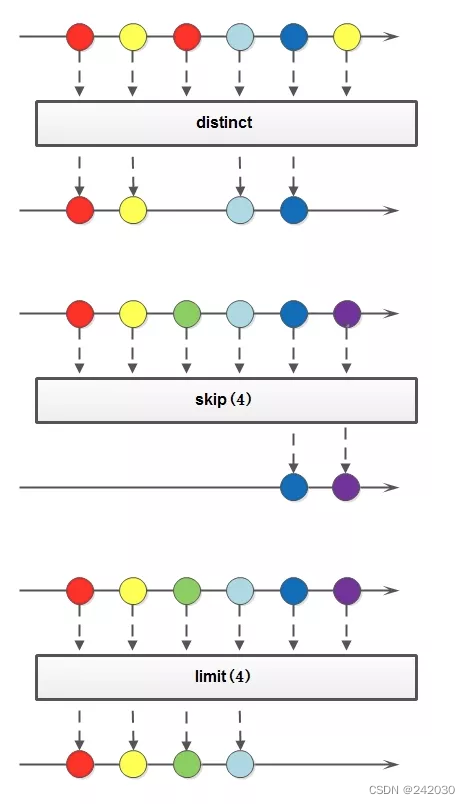
package com.stream.test14; import java.util.List; import java.util.stream.Collectors; import java.util.stream.Stream; public class Test14 { /** * 提取/组合 * * @param args */ public static void main(String[] args) { String[] arr1 = {"a", "b", "c", "d"}; String[] arr2 = {"d", "e", "f", "g"}; Stream<String> stream1 = Stream.of(arr1); Stream<String> stream2 = Stream.of(arr2); // concat:合并两个流 distinct:去重 List<String> newList = Stream.concat(stream1, stream2).distinct().collect(Collectors.toList()); // limit:限制从流中获得前n个数据 List<Integer> collect = Stream.iterate(1, x -> x + 2).limit(10).collect(Collectors.toList()); // skip:跳过前n个数据 List<Integer> collect2 = Stream.iterate(1, x -> x + 2).skip(1).limit(5).collect(Collectors.toList()); System.out.println("流合并:" + newList); System.out.println("limit:" + collect); System.out.println("skip:" + collect2); } }- 1
- 2
- 3
- 4
- 5
- 6
- 7
- 8
- 9
- 10
- 11
- 12
- 13
- 14
- 15
- 16
- 17
- 18
- 19
- 20
- 21
- 22
- 23
- 24
- 25
- 26
- 27
- 28
- 29
# 程序输出 流合并:[a, b, c, d, e, f, g] limit:[1, 3, 5, 7, 9, 11, 13, 15, 17, 19] skip:[3, 5, 7, 9, 11]- 1
- 2
- 3
- 4
至此,Stream 的常用功能介绍完毕!
-
相关阅读:
小学生C++趣味编程 视频集
953a-954(fpdlink3)寄存器配置
Vue知识系列(4)每天10个小知识点
Java实现更新excel文件内容
Conformer Encoder GPU 加速策略较全面汇总
CSS3 grid 网格/栅格布局
Python操作Excel教程(图文教程,超详细)Python xlwings模块详解,
TypeReference使用笔记
behave结果转化为cucumber结果,主要用于将behave.json转化为cucumber.json
Hive默认分割符、存储格式与数据压缩
- 原文地址:https://blog.csdn.net/qq_30614345/article/details/132508621
